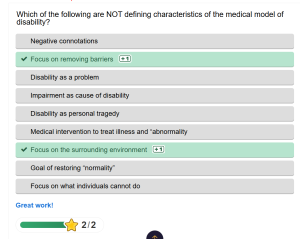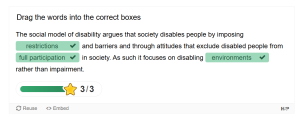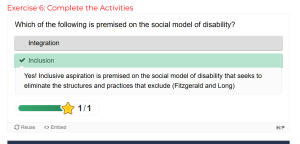5
Q & A for Chapter Five
https://padlet.com/kellymcguire/question-and-answer-board-for-chapter-five-jx5xdu92k8ohr53n
Section One: The Fundamentals
Introduction: Disability Rights and Ableism
Exercise 1: Notebook Prompt
How prevalent are these forms of security among disabled people you know? Or, if you identify as a disabled person, would you say your social surroundings and community foster and support these kinds of security? Furthermore, while the focus of the article is on Kinesiology programs, it is also important to reflect on how academia in general accommodates for disability. If you feel comfortable answering this question, what has been your experience of postsecondary education to date?
-OR-
The authors also observe that “Ableism not only intersects with other forms of oppression, such as racism, sexism, ageism, and classism, but abilities are often used to justify such negative ‘isms’.”
What do you think this means? Provide an example.
| I think this means that ableism is intertwined with other forms of oppression. In history, society tends to use people’s disabilities against them [which ties in to how the medical model lays the blame on the individual for having the disability]. If you look at the history of eugenics, people who have low iq’s and other forms of disabilities were sterilized against their knowledge and not able to reproduce. It was a terrible practice that took the opportunity of parenthood away from people they did not deem fit by their standards to have children.
|
Exercise 2: Implicit Bias Test
Did anything surprise you about the results of the test? Please share if you’re comfortable OR comment on the usefulness of these kinds of tests more generally.
| I think these kinds of tests are very useful. When you look at a field such a social work, there tends to be bias that the workers can unconsciously use while they are working with families. When you take tests like the implicit bias test, you can identify what your triggers might be and what bias you may have on a certain situation based on what you have experienced.
|
A) Keywords
https://padlet.com/kellymcguire/keywords-collection-for-chapter-five-qi79ggw9na79tzb5
Exercise 3:
Add the keyword you contributed to the padlet and briefly (25 words max) explain its importance to you.
|
|
B) On Disability
Exercise 4: Complete the Activities



Exercise 5: Notebook Prompt
What do Fitzgerald and Long identify as barriers to inclusion and how might these apply to sport in particular?
|
|
C) Inclusion, Integration, Separation
Exercise 6: Complete the Activities

Exercise 7: Notebook Prompt
Choose ONE of the three questions Fitzgerald and Long argue disability sport needs to address and record your thoughts in your Notebook.
- Should sport be grouped by ability or disability?
- Is sport for participation or competition?
- Should sport competitions be integrated?
| I think sports should be for participation. My main reasoning behind this is when we start to put a ‘value’ on something that is supposed to give you joy, you risk intense burn out. All of the atheletes we see today have spent years, if not their entire lives practicing for their sports. They have been through great journeys so imagine when they end up placing last in a sport they care about. Eventually it will lead them to wanting success at the cost of their mental health.
|
Part Two: Making Connections
A) Gender, Sport and Disability
Exercise 8: Complete the Activity
The paradox that sportswomen habitually face (as the authors observe, this isn’t confined to disabled sportswomen) involves the expectation they will be successful in a ‘masculine’ environment while complying with femininity norms in order to be recognized as a woman.
True or false?
Take a moment to reflect on this paradox below (25 words)
| This statement is accurate when describing the paradox that sportswomen face. They are expected to succed in sports that are seen as masculine but they must also fit into society’s expectation of femininity.
|
B) Masculinity, Disability, and Murderball
Exercise 9: Notebook/Padlet Prompt
Watch the film, Murderball and respond to the question in the padlet below (you will have an opportunity to return to the film at the end of this module).
The authors of “Cripping Sport and Physical Activity: An Intersectional Approach to Gender and Disability” observe that the “gendered performance of the wheelchair rugby players can…be interpreted as a form of resistance to marginalized masculinity” (332) but also point out that it may reinforce “ableist norms of masculinity.” After viewing the film, which argument do you agree with?
a) Murderball celebrates a kind of resistance to marginalized masculinity
| The film does both in a way. Murderball shows us that men with disabilities [in this case we’re talking about the men who are in the wheelchair rugby team] can be seen as powerful and masculine despite how society might usually view people in wheelchairs as less than. This film talks about stereotypes about disabilities and shows us that these men are just as strong, just as active [sexually], just as powerful and competitive. However, this film also fall into reinforcing ableist norms by constantly looking at traditional masculine attributes to almost confirm the worth of the atheletes. As an example, when they speak about their intimate lives. They speak about how they are still able to have sex in wheelchairs and such but it ties into how a man is viewed, combining being still considered ‘real men’ with their ability to still sexually please.
|
Section Three: Taking a Shot
A) Resistance
B) Calling out Supercrip
Exercise 10: Mini Assignment /longer prompt (worth 5% in addition to the module grade)
1) Do you agree with the critique of the “supercrip” narrative in this video? Why or why not? Find an example of the “supercrip” Paralympian in the 2024 Paris Paralympics or Special Olympics coverage and explain how it works.
| I do agree with the critique of the ‘supercrip’ narrative. Similar to Murderball, the video and this movie promote the fact that people who are disabled are still able to be fulfilling in their sports [for lack of a better word]. However, disabled athletes are viewed as special or extraordinary just because they were able to overcome their disability, not based on their atheletic skills alone. An example of supercrip narrative would be the ‘Considering What’ campaign. This campaign was created to help the public reconsider how they view Paralympic atheletes and their ‘greatness’. It brings a more realistic perspective and allows paralympiams to be shown as atheletes who are great in their sport rather than viewed as ‘superheros’ and so on.
https://www.paralympic.org/paris-2024/news/channel4-paralympic-campaign-changes-attitudes
|
2) Does the film Murderball play into the supercrip narrative in your opinion? How does gender inform supercrip (read this blog for some ideas)?
(250 words for each response)
| In my opinion, this firm did play into the supercrip narrative. As I mentioned before, the film allowed us to see into the world of disabled athletes and their struggles. We saw how each member over came their disability and were able to function just as any man in society would. This film also focused alot on the disabilites and histories of the athletes more than their abilities.
Gender can play a role in informing supercrip by influencing certain stereotypes atheletes might face. Men who are disabled are viewed as being strong and still physically able to perfom well in masculine sports despite their disability. It ties into the perspective of what a man should do in society [always be strong, dominant, assertive, etc.]
|

